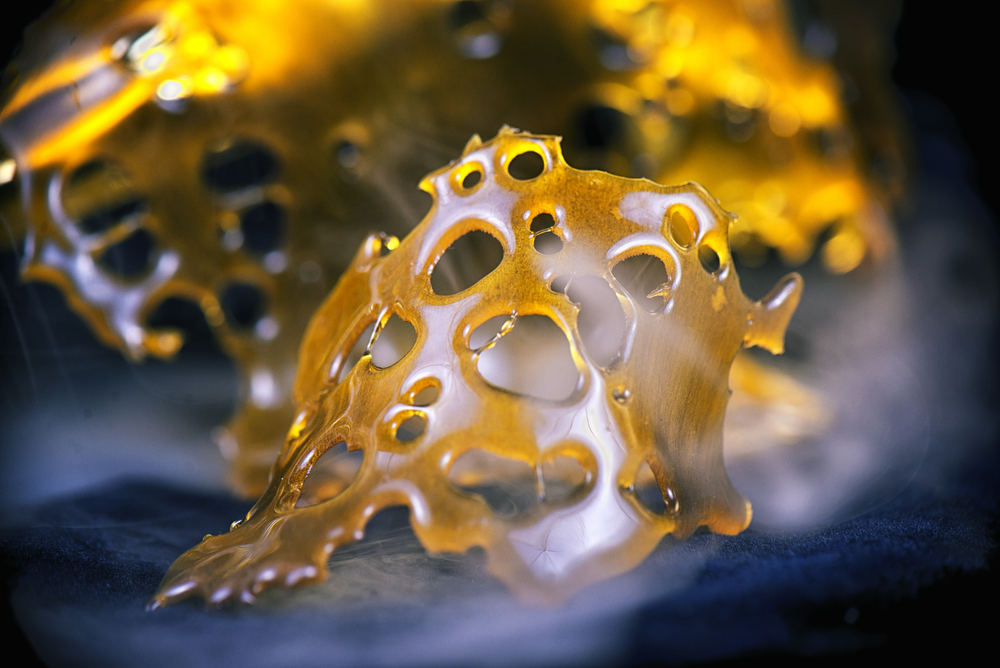- Like with everything in life, everyone has their own preferences when it comes to consuming cannabis, and while some people prefer flowers, others are more into concentrates.
- In this article, we step into a universe that can seem vast and complex: that of cannabis extracts.
- Read on to find out which different types of solvent-based and solventless extracts you can obtain from a cannabis plant.

Solventless extracts
As the name suggests, the methods below do not involve solvents. All you'll need is water, heat, pressure and a series of mesh screens.
Ice-o-lator hash/bubble hash/water hash
Despite the different names, these three techniques rely on the same elements, i.e. a 5-10L bucket (depending on the amount of plant material to be processed) and a series of interlocking bags with mesh screens of various sizes specifically designed for "Ice-O-Lator" type extracts, which are nested inside one another from smallest to biggest.

As a first step, the bucket is filled to two thirds of capacity with cold water and a good amount of ice, as this facilitates the break off of trichomes from the buds. This can be further encouraged by keeping the flowers in the fridge for an hour before getting started.
The bagged buds are then plunged into the iced water and shacked for 20-25 minutes, after which the water is poured through the bags and the resin is collected from the screens. This is then compacted by hand and left to dry on a plate for about a week, either somewhere outdoors or in a room with a temperature of 20-22 ºC and 55-60% humidity. Consider that poor drying can alter the taste of the extract and encourage mould growth, rendering the product unfit for consumption.
Dry sift
Dry sift is the cheapest, simplest cannabis extraction method, and thus also the most popular among consumers. All that is needed is a bag with a mesh screen of the desired size, like the ones used for the Ice-O-Lator method. Smaller mesh sizes – e.g. 50 microns – allow you to collect smaller resin glands, making for a better-quality result. So depending on your mood, you can play with different mesh sizes to produce different quality concentrates.

You can start out with a 150-micron mesh bag for a first sifting and see if you are happy with the result. In any case, a 70-micron mesh should be small enough to produce top-class dry sift hash. Just insert the plant material in the bag with the desired mesh size and agitate it gently up and down over a flat, clean, dry surface from where to collect the resin trichomes. You'll see that some slight movements are enough to cause the trichomes to break off from the buds and form a powder-like kief on the collecting surface.
The last step consists of compacting the trichomes into a uniform piece of hash using a rigid card – e.g. a credit card. Before you start, make sure the plant material is completely dry. Also, keep it in the freezer for about an hour in order to encourage the break off of the trichomes. Contrary to water hash, dry sift hash does not require drying and can be used straightaway.
RosinTech

Rosin concentrates can be produced with just some bud or trichome-covered plant material, parchment paper and a heat press. The simplest, cheapest way to proceed is to use a hair straightener, which also allows for manual temperature control.
Just place the buds on the parchment paper, fold it into a compact rectangle and use the hair straightener to apply heat and pressure. This will cause the resin to melt and stick to the parchment paper. And there you go, your rosin is ready to be enjoyed. If you wish so, you can try different temperatures in order to press different amounts of product.
Solvent-based extracts
This section takes a look at methods that involve the use of a chemical solvent (hydrocarbon). The increasingly far-reaching international cannabis scene is facilitating the development of new extraction techniques that allow in turn for new forms of premium quality concentrates. Before opting for one of these methods, though, it is important to be well informed about the possible dangers, as the handling of certain chemical substances and technical devices can carry serious risks, including explosion and fire. For your own safety, make sure to take all the necessary precautions and to become fully conversant with your method of choice before using it.
BHO (Butane Hash Oil)
As the name implies, this extraction method involves the use of butane gas. Gases and hydrocarbons are common chemical solvents, with alternatives including propane, hexane, dimethyl ether (better known as dexso and DHO) and a method hybrid known as DBHO, which combines BHO and DHO.

While the method remains the same regardless of the chemical solvent, the properties of the concentrate – colour, density, viscosity, viscoelasticity, etc. – vary accordingly, producing different looking concentrates with multiple names – oil, wax, shatter, honeycomb, nectar, etc.
The science behind it is pretty simple: the plant material is introduced in an airtight container and the chemical solvent is then injected at high pressure. Once inside, the solvent passes through the plant material and extracts the essential oils containing the active ingredients of the plant (cannabinoids, terpenes and flavonoids).
As a last step, traces of solvent are removed by heating the concentrate to the minimum evaporation temperature. This allows to preserve the organoleptic properties while ensuring a product that is pure, clean, palatable and safe to consume. The use of hydrocarbons allows to extract up to 90% of a plant's cannabinoids.
Rick Simpson Oil (RSO)
Rick Simpson Oil is a high-grade cannabis concentrate that is often used therapeutically for treating diseases of varying severity. Also known as Phoenix Tears, it is named after its creator, a Canadian who has garnered much media attention over the last few years because of his technique.
RSO is often used therapeutically, both for treating physical and psychological disorders.
RSO is quite simple to produce. The plant is immersed in ethyl or isopropyl alcohol in order to trigger cannabinoid extraction and the resulting solution is heated – e.g. on the stove – until the solvent is evaporated. As a result, a thick, blackish oil is obtained.
RSO is typically administered orally as a tincture, generally as sublingual drops that are held under the tongue for some seconds and then swallowed. The flavour might not always be what one would describe as pleasant, but the benefits of the product more than make up for this little inconvenience. Often presented in syringes or bottles to facilitate administration of the drops, RSO can also be applied topically.
Tinctures

Cannabis tinctures are produced by means of alcoholic extraction, which, contrary to BHO, allows to efficiently extract cannabinoids and terpenes without the need to use a source of heat. The result is very similar to RSO but with the advantage of nicer flavour in most cases.
Like RSO, tinctures are generally administered as sublingual drops and, according to results, are effective in treating a number of conditions. Both products are in fact quite similar, with the difference that RSO is thicker in texture.
Live Resin

Developed between 2011 and 2013 in Colorado by William Fenger, known under the pseudonym Kind Bill, and by Giddy Up, founder of EmoTek Labs, live resin is one of the newest resin extraction methods.
The technique involves putting freshly harvested cannabis directly in the freezer so as to avoid drying, a process that can have a devastating effect on terpenes, which tend to degrade when exposed to air, light, heat and handling for long periods of time. However with live resin, the buds retain all their terpenes and cannabinoids, and thus the plant's original flavour, aroma and effect, resulting in a much higher quality final product.
Supercritical Extraction (CO2)

Supercritical CO2 extraction is the most sophisticated method developed so far, and as such it produces the purest concentrates. Instead of a chemical solvent, the technique uses carbon dioxide, which is compressed into an oily supercritical fluid that extracts cannabinoids and terpenes in a way similar to hydrocarbons (butane, propane, hexane).
Supercritical fluids can change from a fluid state to a gaseous state when exposed to certain temperatures. Among other advantages, concentrates produced with this technique tend to contain about 10 per cent more terpenes than concentrates produced otherwise. On the negative side, the technique requires the use of costly equipment aimed at highly trained chemical operators capable of managing the associated risks (explosion, fire).
The method has become commonplace in the medical industry, where it is widely used for producing high-quality concentrates. But given the sophistication of the equipment involved, we recommend that you opt for another method unless you have the necessary technical skills.
Molecular breakdown
Molecular breakdown allows to separately isolate the plant's cannabinoids and terpenes, preventing the degradation of the various molecules. The method utilises a 0.01 mmHg vacuum level that allows low temperature distillation of high-boiling substances. Because the molecules are not exposed to high temperatures for long periods of time, heat degradation is no longer something to worry about.
Now that you have a clearer idea of the different concentrates that can be obtained from a cannabis plant, we wish you the best of success with the extraction method of your choice.



Comments from our readers
There are no comments yet. Would you like to be the first?
Leave a comment!Did you like this post?
Your opinion about our seeds is very important to us and can help other users a lot (your email address won't be made public).